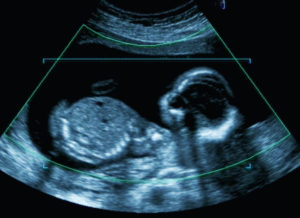
Many women are usually not clear about getting the right count of the exact number of weeks. Here are answers to a few common questions on calculating a woman’s pregnancy.
Table of Contents
How many weeks pregnant are you?
Starting from the first day of the prospective mother’s last menstrual period, there are about 40 weeks in a pregnancy. Pregnancy is usually calculated as per the date of the Last Menstrual Period (LMP).
To calculate how many weeks pregnant the prospective mother is, the doctor asks her about the last period date. The first day of her LMP is counted as the first day of the pregnancy.
The normal length of a pregnancy can vary from 37 to 42 weeks. You can expect the baby to come out any time during this time. If the birth of the baby is before 37 weeks of her pregnancy then the baby could be premature. Above all, premature babies need extra care.
Also Read: What Vaginal discharge in pregnancy is normal?

Alternative Methods To Calculate Your Pregnancy Due Date
Besides these mathematical ways, physicians also use alternative methods to determine the pregnancy due date. Using these methods at home is impossible; however, prenatal care is crucial for ensuring the healthy development of the baby in the womb, therefore you can just ask your practitioner to use them to help you confirm the due date.
Ultrasonography
Ultrasonography is a non-invasive procedure that helps doctors see what’s going on inside your womb; this procedure is also one of the most accurate in establishing the due date. The earlier you get the first ultrasound the better because your practitioner will be able to establish the date you conceived with more accuracy.
Although this procedure is performed routinely in many cases, some practitioners can only recommend an early ultrasound if the pregnancy is considered at risk. In fact, your doctor may only perform a routine early ultrasound if you’re over 35, have had miscarriages in the past, or you’re facing pregnancy complications due to your medical history.
However, your physician can’t deny you an early ultrasound if you ask for one. So, if you want to check the accuracy of your calculations, ask your physician to perform an early ultrasound.
Pregnancy Milestones
Pregnancy milestones also offer indications on whether your pregnancy due date is correct or not, which is less accurate than an early ultrasound, One of them is the fetal heartbeat which is heard for the first time at about 9 to 12 weeks.
As it’s easy to understand, this milestone indicates the due date with a three-week inaccuracy but fetal measurements can help the doctor understand how many weeks pregnant you are. The same goes for the first feel of fetal movement, which happens between the 16th and the 22nd week.
When you actually feel the first movement depends on how many pregnancies you had; other factors can also influence it.
Fundal Height Measurement
The fundal height refers to the top of your uterus that should reach your navel at about week 20. Your practitioner uses this measurement to determine your gestational age, and you can also use this figure to confirm the due date.
Yet again, the figure is only indicative. Some women have higher fundal height and in this case, it may happen to give birth after the “traditional” 42 weeks. This only happens because of a miscalculation of your gestational age, which means your baby is still born on term.
Uterus Size
The size of the uterus also offers essential signs about your gestational age and due date. Practitioners tend to measure the size of the uterus at each prenatal check and standard measurements allow you to use these numbers to determine the gestational age, thus the due date.
Yet again, the figure is inaccurate and it depends on your morphology.
What if you don’t know the date of your last period or have irregular periods?
The due date calculation works best if the menstrual cycle happens on a regular interval and the periods take place every 28 days. Just in case, one has an irregular menstrual cycle, she might be unable to figure out her date of LMP. Also, if the cycle varies in length, calculating from the first day of her LMP might not give a trustworthy date. However, it can be really tough figuring out the date of the last period if the prospective mother has irregular period.
The first ultrasound of the prospective mother accurately tells us about the due date of the baby. The sonographer will give an estimate idea of how far along is the pregnancy which may vary with the difference of seven days (prior and after).

Online due date calculators generally rely on the simple rule. The predicted childbirth is exactly 280 days after the last menstrual period before getting pregnant. Franz Naegele, a German obstetrician’s rule:
Naegele’s Due Date Calculation
This is the simplest method to calculate your due date. The method was established by a German obstetrician in the early nineteenth century and bases the calculation on a perfect 28-day cycle with ovulation taking place on day 14.
Based on this assumption, you’ll deliver your baby after 280 days, or nine months and one week, from the first day of your last period.
Therefore, to calculate your pregnancy due date, add nine months and 7 days until the first day of your last period. For example, if the first day of your last period was April 1, your pregnancy due date is January, 8 the following year.
However, most women don’t have perfect cycles and ovulation doesn’t always occur on day 14. That’s why, the due date obtained through this method is only a rough estimate.
Can’t I just calculate from the date I conceived?
You can. But that would mean knowing exactly when you conceived. It’s trickier than you might think. Even if you do know exactly what day you had sex, sperm can live in the woman’s body for up to five days, and the egg can live for up to 24 hours after being released.
As a rule of thumb, some experts suggest adding two days to the date of intercourse and counting from then. The Mittendorf-Williams rule is probably still most accurate.
Mittendorf-Williams Due Date Calculation
“The physicians Robert Mittendorf and Michelle Williams developed a computer model for estimating due dates.“
According to a study conducted in 1990 by Mittendorf and Williams, Naegele’s rule isn’t exactly accurate and that the actual term for labor is with 2-4 days longer. Their research showed that the average due date for first-time mothers is 288 days. This figure drops to 283 days for multiparas, which is still longer than the 280 days predicted by Naegele.
As a result, Mittendorf and Williams came up with their own algorithm that suggests counting back three months from the first day of the last menstrual period, then add 15 days for the first baby or 10 days for subsequent pregnancies.
Know about gestational age
Conceptional age is the age of the baby when he or she was conceived. Gestational age is the baby’s age from the last menstrual period, which should fall about two weeks earlier than that.
When the prospective mother undergoes an ultrasound, however, gestational age means something entirely different. Here, the ultrasound technician guesses the baby’s age based on its measurements as opposed to calculating from conception or last period.
The ultrasound does not match the calculated age of a fetus which is normal in gestational age. But discrepancies may be signs of developmental problems. It may also be merely a sign that the due date was miscalculated.

Final Thoughts
Calculating an accurate pregnancy due date is often impossible, but there are many medical checks and tests you can use to verify the accuracy of your calculations. Even if you have an accurate due date, remember that most babies may be born two weeks before or after the estimated date, therefore you shouldn’t worry if the baby comes out sooner or later than your due date.
A normal pregnancy can last anywhere between 38 and 42 weeks; an irregular period or a miscalculation of the date you conceived can easily mess your results. Moreover, the physician changes and adjusts the due date estimate based on the progress of the gestation.
Also Read: 9 Benefits of Coconut Water During Pregnancy












This article provided me with perfect ways to calculate pregnancy due date. Getting accurate pregnancy due date is impossible. Even the alternative methods given in the article works well.